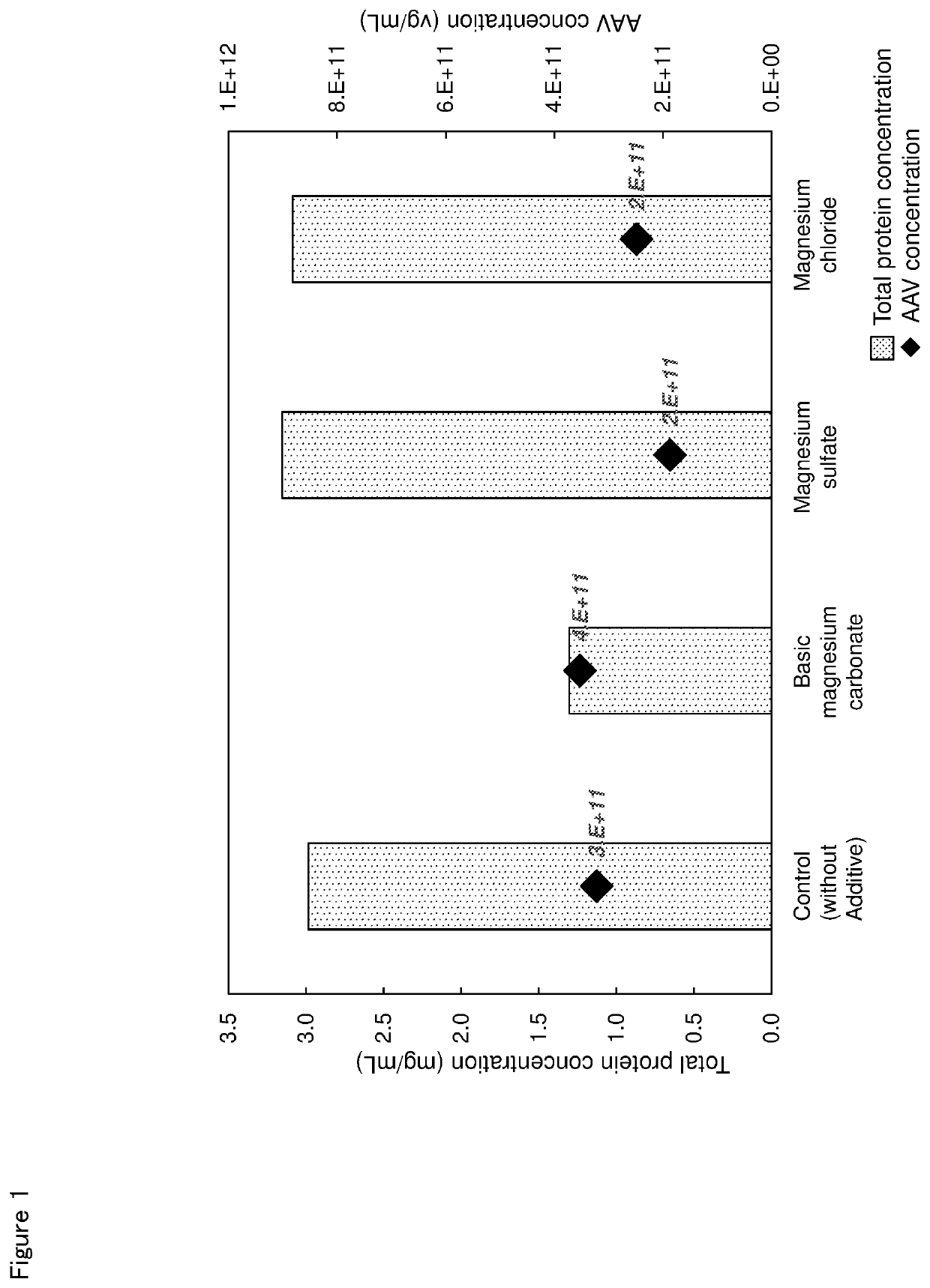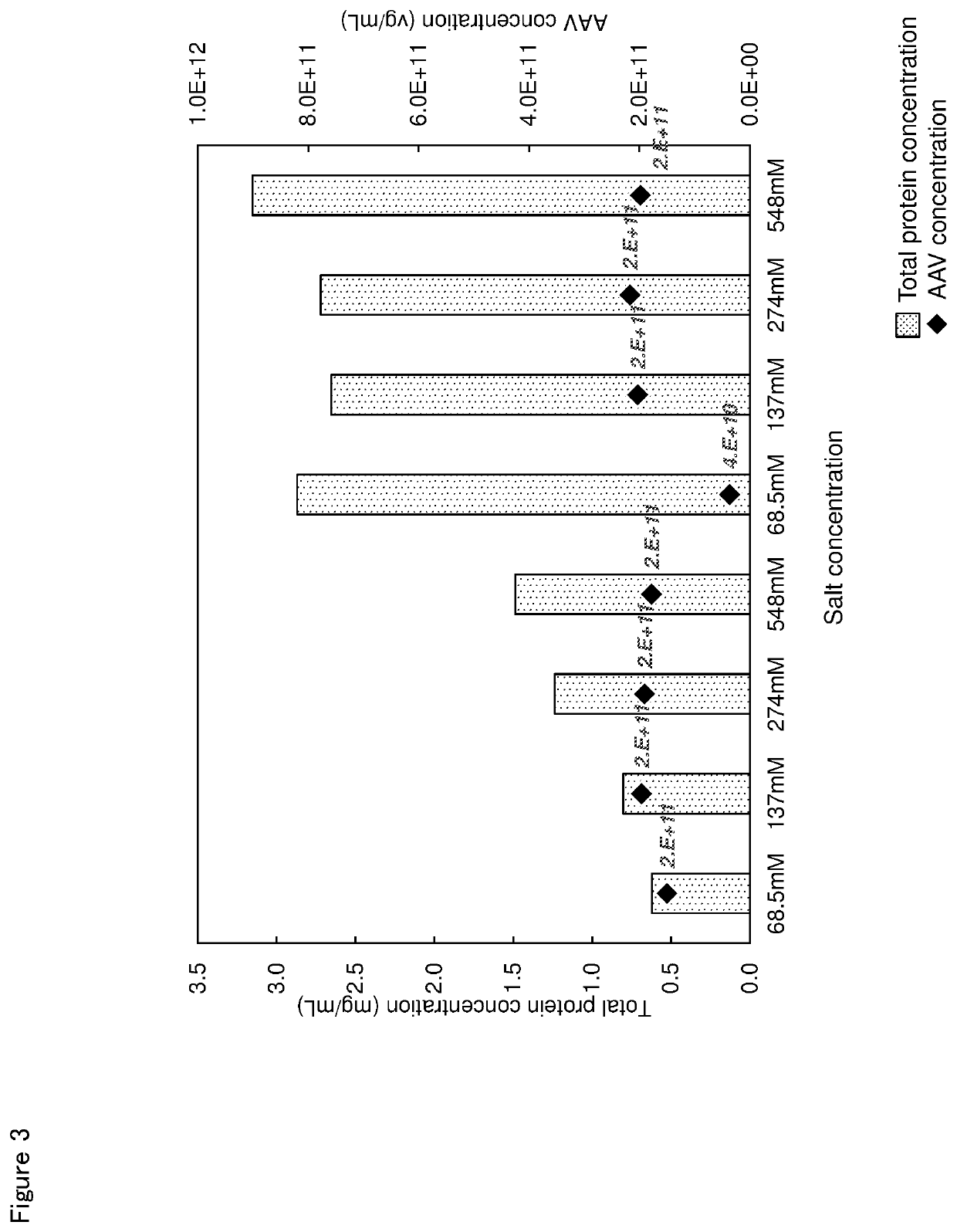Method for purifying virus or virus-like particle
- Summary
- Abstract
- Description
- Claims
- Application Information
AI Technical Summary
Benefits of technology
Problems solved by technology
Method used
Image
Examples
example 1
[0079](1) Preparation of Adeno-Associated Virus (AAV)-Producing Cell
[0080]A plasmid that produced AAV2 and that expressed VENUS (GenBank:ACQ43955.1), which is an altered fluorescent protein GFP, was prepared using AAV vector preparation kit (“AAVpro® Helper Free System” manufactured by Takara Bio).
[0081]The cultured HEK293 cell was transfected with the prepared plasmid using transfection reagent (“Polyethylenimine MAX” manufactured by Polysciences, MW: 40,000) to produce AAV. The cell was released after the cultivation, and the cell culture fluid was recovered. The cell culture fluid was centrifuged to remove the supernatant and to obtain AAV-producing cell.
[0082](2) Evaluation of Ability of Magnesium Salt to Remove Impurity Protein
[0083]The AAV-producing cell obtained as the above (1) was suspended in Dulbecco's Phosphate Buffered Saline (manufactured by Sigma-Aldrich, hereinafter abbreviated as “PBS”) containing 0.1% Triton® X-100, and the suspension was stirred in ice for 20 minu...
example 2
n of Effect of Additive Amount of Basic Magnesium Carbonate on Impurity Protein Removal Rate
[0086]The pre-treated liquid was prepared similarly to Example 1, and PBS was added thereto in a ratio of 100 v / v %. Then, 1, 5, 10 or 20 w / v % of basic magnesium carbonate to the volume of each solution was added, and the AAV amount and the mass of total proteins were measured. In addition, the pre-treated liquid was diluted using PBS without adding an additive as control and similarly evaluated. The result is shown in Table 2 and FIG. 2.
TABLE 2Additive amount ofAAVTotal proteinbasic magnesium carbonateconcentrationconcentaration(w / v %)(vg / mL)(mg / mL)Without addition3.2E+112.99 1%4.2E+112.42 5%3.7E+111.7510%3.5E+111.3020%2.8E+111.05
[0087]When the additive amount of basic magnesium carbonate was larger in the range of 1 to 20 w / v % to the solution, the total protein concentration was low and the effect to reduce an impurity was high as the result shown in Table 2 and FIG. 2. In addition, when ...
example 3
n of Effect of Salt Concentration on Impurity Protein Removal Rate
[0088]A phosphate buffer of pH 7.4 (0.2 g / L dipotassium hydrogen phosphate, 2.9 g / L disodium hydrogen phosphatedodecahydrate) and 1 M sodium chloridephosphate buffer of pH 7.4 (0.2 g / L dipotassium hydrogen phosphate, 2.9 g / L disodium hydrogen phosphatedodecahydrate, 58.4 g / L sodium chloride) were prepared. The pre-treated liquid was prepared similarly to Example 1, and AAV solution having a final concentration of sodium chloride of 68.5 mM, 137 mM, 274 mM or 548 mM was prepared using the above-described 2 kinds of phosphate buffers in place of 100 v / v % of PBS. Basic magnesium carbonate was added to the solution in a concentration of 10 mass %, and the AAV amount and the mass of total proteins were measured. In addition, the pre-treated liquid was diluted using PBS without adding basic magnesium carbonate as control and similarly tested. The result is shown in Table 3 and FIG. 3.
TABLE 3NaClconcentarationAAVTotal prote...
PUM
 Login to View More
Login to View More Abstract
Description
Claims
Application Information
 Login to View More
Login to View More - R&D
- Intellectual Property
- Life Sciences
- Materials
- Tech Scout
- Unparalleled Data Quality
- Higher Quality Content
- 60% Fewer Hallucinations
Browse by: Latest US Patents, China's latest patents, Technical Efficacy Thesaurus, Application Domain, Technology Topic, Popular Technical Reports.
© 2025 PatSnap. All rights reserved.Legal|Privacy policy|Modern Slavery Act Transparency Statement|Sitemap|About US| Contact US: help@patsnap.com



